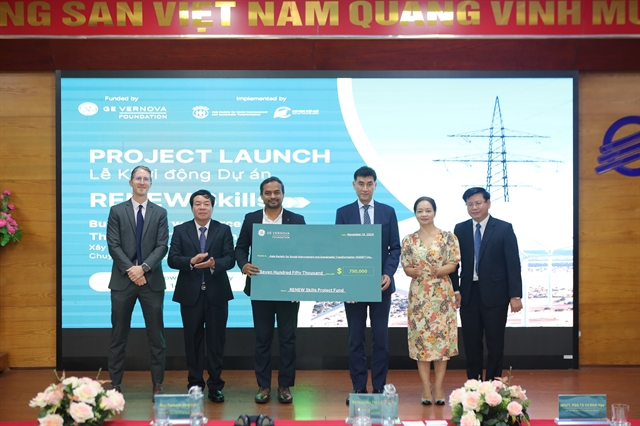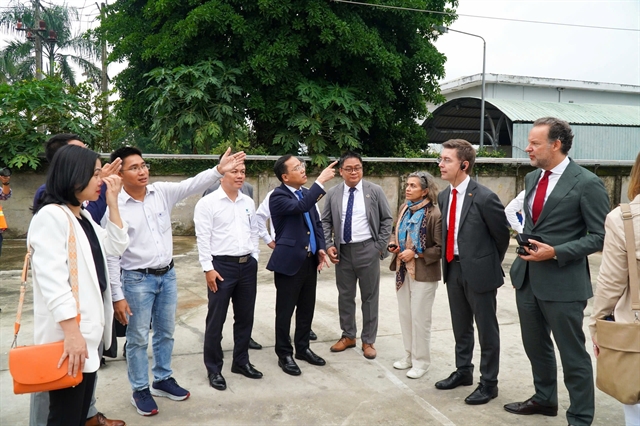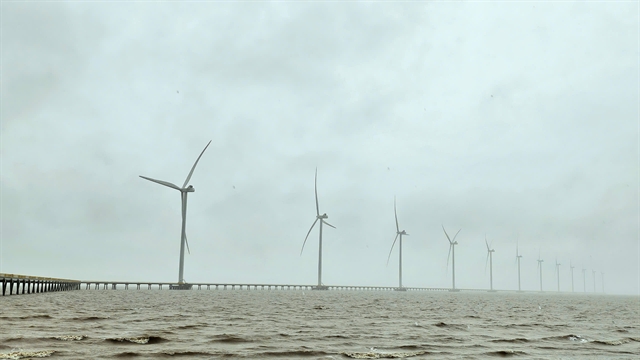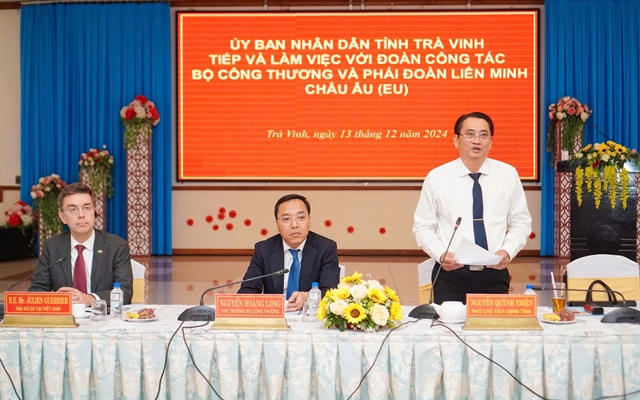 Economy
Economy

Ly Ly Cao
HÀ NỘI — The European Union (EU) continues to solidify its position as a key partner in Việt Nam’s transition to renewable energy, with recent collaboration efforts bringing promising developments to the forefront, particularly in Cần Thơ City and Trà Vinh Province.
These regions represent the potential for sustainable energy growth, supported by EU-backed initiatives under the Việt Nam - EU Sustainable Energy Transition Programme (SETP).
On December 12 and 13, delegations from the Ministry of Industry and Trade (MoIT) and the EU, led by Ambassador Julien Guerrier, met with local officials to assess progress in energy transition projects.
In Cần Thơ, efforts have already provided electricity to over 99.97 per cent of households, with rural electrification projects, such as the EU-funded 2018 – 2020 rural grid expansion, delivering energy access to over 1,400 households.
Deputy Minister of Industry and Trade, Nguyễn Hoàng Long, praised these efforts.
“The EU’s support has not only improved electricity access in rural areas but has also laid a foundation for sustainable economic growth. Electrification empowers communities and drives local development,” he said.
Trà Vinh Province has also made significant strides. Over the past decade, it has connected more than 40,000 households to the national grid through investments exceeding VNĐ700 billion (US$27.6 million).
Renewable energy projects, including wind and solar, have significantly contributed to these advancements. As of 2024, the province’s renewable energy capacity stands at 505 MW, with several projects under development to increase this capacity further.
 |
| Delegates visiting Cần Thơ City. — Photo courtesy of the organiser |
Renewable energy potential
Ambassador Guerrier emphasised Việt Nam’s geographic advantages, particularly in wind and solar energy.
“The geography of Việt Nam is a very favourable environment to develop such wind farms near shore and also offshore,” Guerrier told Việt Nam News during a site visit in Trà Vinh Province.
“There is a very large continental shelf and very strong winds, so there is a huge potential to produce electricity here not only for the needs of Việt Nam but also for the needs of surrounding countries in Southeast Asia.”
The province’s coastal location makes it a prime candidate for offshore wind projects, with plans to develop over 800 MW of wind power by 2030.
In Cần Thơ City, rooftop solar energy is gaining traction. Over 2,000 households and businesses have adopted solar installations, producing over 80 MW of electricity.
Ambassador Guerrier highlighted the need to optimise these systems through policies enabling the sale of excess electricity to nearby industries or the national grid.
“Such measures can maximise the utility of rooftop solar across the country,” he said.
Nguyễn Hoàng Long further stressed the importance of renewable energy for industrial zones, stating that: "Our industrial parks are expanding rapidly. Green energy is essential not only to meet the demand but also to fulfil the stringent green standards of international markets.”
Lisa Nguyễn, Sales Manager at CN Green Roof Asia, a company co-funded by the European Union and a specialist in renewable energy for the industrial and Commercial (C&I) sector, said that the company’s clients had saved over 5,600 tonnes of CO2 through rooftop installations during 2022 - 2023.
These CO2 savings were eligible for carbon credit trading, but solely within the domestic market and at a cheap price, she said, adding that last year, the credits were sold to LG in Hải Phòng City for less than $1.
 |
| The near-shore wind farm, funded by the EU, is in Trà Vinh Province. — VNS Photo Ly Ly Cao |
Long-term vision
The EU’s financial and technical assistance underlines its commitment to Việt Nam’s energy transition. The SETP programme has allocated €142 million in grants for the period 2022 - 2027 to support clean energy initiatives.
The EU also champions cross-border energy interconnections in Southeast Asia, which could position Việt Nam as a regional leader in clean energy exports.
“Given the promising prospects, EU has already been investing in the grid interconnections between Southeast Asian countries. I believe that projects like Trà Vinh can be replicated and multiplied not just in Trà Vinh but across many provinces on the coast of the East Sea,” Ambassador Guerrier said.
The EU’s partnership extends beyond funding. It includes knowledge-sharing, technical expertise and pilot projects, such as rooftop solar at Cần Thơ’s De Heus facility. This installation is projected to reduce CO2 emissions by 470 tonnes annually, underscoring the tangible benefits of renewable energy solutions.
Ambassador Guerrier noted that projects like these demonstrated the potential for scaling up renewable energy solutions in Việt Nam. The EU was committed to supporting such initiatives that align with Việt Nam’s net zero ambitions.
 |
| The EU Ambassador and the representative of MoIT at a meeting with Trà Vinh's officials on December 13. — Photo courtesy of SETP |
Challenges remain
Despite these advances, there are challenges to address.
Trà Vinh leaders called for expedited legal frameworks to facilitate offshore wind and direct power purchase agreements, while Cần Thơ officials sought additional funding for solar and biomass projects.
Both regions highlighted the need for cohesive policies to attract private investments and ensure the integration of renewable energy into the national grid.
Deputy Minister of Industry and Trade Long acknowledged these challenges but expressed optimism: “The government’s recent policies, such as those encouraging rooftop solar and offshore wind development, pave the way for greater investment. With international support, we can overcome these obstacles.”
Ambassador Guerrier also reiterated the EU’s support that with favourable policies, Việt Nam’s renewable energy projects could accelerate, drawing in investments from the EU and other international stakeholders.
As Việt Nam strives toward its ambitious net zero by 2050 goal, partnerships like the one with the EU play a pivotal role.
Projects in Cần Thơ City and Trà Vinh Province serve as models of how international cooperation can unlock the potential of renewable energy, transforming these regions into hubs of sustainable development. With ongoing investments and strategic planning, the future of clean energy in Việt Nam looks brighter than ever. — VNS




